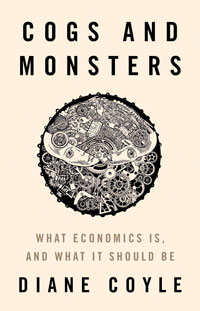Cogs and Monsters: What Economics Is, and What It Should Be

Diane Coyle
Princeton University Press,
Princeton, NJ, 272 pp., $24.95
The past two decades have been a doozy for economics. In the early 2000s, sophisticated financial markets and deepening global economic integration were touted as achievements of modern economic and financial systems, until the global financial crisis prompted questions about why economists had not foreseen the buildup of tensions and vulnerabilities in financial markets and their consequences. Just over a decade later, COVID-19 called into question the wisdom of tightly integrated and globally distributed production chains. These crises cast doubt on earlier beliefs and fueled existing skepticism about capitalism and economics more broadly.
In Cogs and Monsters: What Economics Is, and What It Should Be, Cambridge economist Diane Coyle examines some of these themes. “Cogs” represent what is (presumably) wrong with economics—the artificial and unrealistic assumption in standard economic models of fully rational agents able to optimize complex objective functions. Analogous to the strange creatures on medieval maps that indicated unknown regions, “monsters” allude to the many changes in the global economy, creating new, uncharted territories that current economics is ill-equipped to navigate.
Coyle presents a long list of cogs. Central among them is the stylized nature of economic models. Economists will be eager to point out that any model, to be useful, must abstract from reality. As Coyle herself notes, a map of the London Underground might be a terrible depiction of what London looks like but is extremely useful for its intended purpose: navigating the Tube. But she does not let economists off the hook so easily, pointing to the excessive “mathiness” of economics, often obscuring underlying assumptions. While this is a valid criticism, her solution of embracing “theoretical ad-hoc-ery” is unlikely to improve the credibility of economic models.
In general, however, Coyle manages to separate genuine criticisms of economics from straw men often built by critics. This is not without building some straw men of her own. For example, she laments the Pareto criterion—that a policy is desirable only if no individual is made worse off—as not useful for policymaking. But most economists do not see it this way. Take trade policy: most would support trade liberalization as a policy creating more gains than losses. The problem here is not that the Pareto criterion is violated, but that policymakers rarely make good on their promise to compensate the losers.
Loading component...
The author also describes what plagues the profession itself, including entrenched networks preventing fresh ideas, an aggressive debating culture, and a lack of gender and racial diversity. It is a long list, and this means less attention can be devoted to other topics. Coyle convincingly outlines the difficulties the digital economy poses for the measurement of GDP and economic modeling. Missing, however, are some of today’s most pressing issues: What role can and should economic policy play in addressing climate change? How can we make economic growth more inclusive? And what does increasing automation imply for the future of work? Nonetheless, Coyle has persuasively highlighted several important issues the economics profession—in both academia and policy circles—should take to heart.
Opinions expressed in articles and other materials are those of the authors; they do not necessarily reflect IMF policy.








